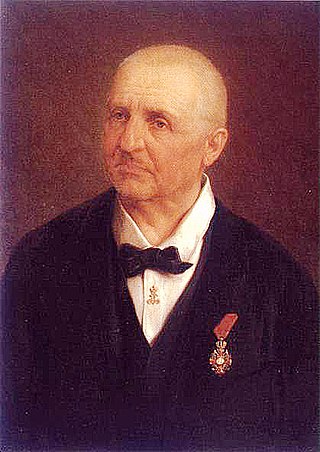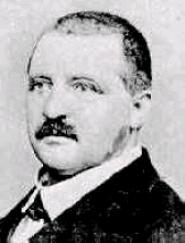Related Research Articles
Robert Wilfred Levick Simpson was an English composer, as well as a long-serving BBC producer and broadcaster.

Music for Strings, Percussion and Celesta, Sz. 106, BB 114 is one of the best-known compositions by the Hungarian composer Béla Bartók. Commissioned by Paul Sacher to celebrate the tenth anniversary of the chamber orchestra Basler Kammerorchester, the score is dated September 7, 1936.

Anton Bruckner's Symphony No. 5 in B-flat major WAB 105, was written in 1875–1876, with minor changes over the next two years. It came at a time of trouble and disillusion for the composer: a lawsuit, from which he was exonerated, and a reduction in salary. Dedicated to Karl von Stremayr, education minister in the Austro-Hungarian Empire, the symphony has at times been nicknamed the "Tragic", the "Church of Faith" or the "Pizzicato"; Bruckner himself referred to it as the "Fantastic" without applying this or any other name formally.

The Symphony No. 2 in E minor, Op. 27 by Russian composer Sergei Rachmaninoff was written from October 1906 to April 1907. The premiere was performed at the Mariinsky Theatre in Saint Petersburg on 26 January 1908, with the composer conducting. Its duration is approximately 60 minutes when performed uncut; cut performances can be as short as 35 minutes. The score is dedicated to Sergei Taneyev, a Russian composer, teacher, theorist, author, and pupil of Pyotr Ilyich Tchaikovsky. The piece remains one of the composer's most popular and best known compositions.

The Symphony No. 9 in D minor, WAB 109, is the last symphony on which Anton Bruckner worked, leaving the last movement incomplete at the time of his death in 1896; Bruckner dedicated it "to the beloved God". The symphony was premiered under Ferdinand Löwe in Vienna in 1903.

Anton Bruckner's Symphony No. 2 in C minor, sometimes known as the "Symphony of Pauses", was completed in 1872. It was actually the fourth symphony composed by Bruckner, after the Symphony in F minor (1863), the Symphony No. 1 in C minor (1866), and the Symphony in D minor (1869).

Anton Bruckner's Symphony No. 3 in D minor, WAB 103, was dedicated to Richard Wagner and is sometimes known as his "Wagner Symphony". It was written in 1873, revised in 1877 and again in 1889.

Symphony No. 5, Op. 50, FS 97 is a symphony composed by Carl Nielsen in Denmark between 1920 and 1922. It was first performed in Copenhagen on 24 January 1922 with the composer conducting. It is one of two of Nielsen's six symphonies lacking a subtitle, the other being his Symphony No. 1.
A Symphony to Dante's Divine Comedy, S.109, or simply the "Dante Symphony", is a choral symphony composed by Franz Liszt. Written in the high romantic style, it is based on Dante Alighieri's journey through Hell and Purgatory, as depicted in The Divine Comedy. It was premiered in Dresden in November 1857, with Liszt conducting himself, and was unofficially dedicated to the composer's friend and future son-in-law Richard Wagner. The entire symphony takes approximately 50 minutes to perform. It premiered on 7 November 1857.
The Symphony No. 2 by William Walton was written between 1957 and 1960, and premiered in September 1960. It received a mixed reception at first: some critics thought Walton's music old-fashioned. Subsequently it has been re-evaluated and praised. The work was first performed by the Royal Liverpool Philharmonic Orchestra, conducted by John Pritchard and was first recorded by the Cleveland Orchestra, conducted by George Szell. It has subsequently been recorded by conductors from Britain, the US and elsewhere.
The Symphony No. 1 in B♭ minor is one of two symphonies by the English composer William Walton. The composer had difficulty in completing the work, and its first public performance was given without the finale, in 1934. The complete four-movement work was premiered the following year.
The Symphony No. 3 by Robert Simpson was written in 1962 and dedicated to veteran composer Havergal Brian. The premiere was given by the City of Birmingham Symphony Orchestra on 14 March 1963 under the conductor Hugo Rignold. Its BBC Proms premiere was given by the Royal Philharmonic Orchestra on 21 August 1967 under the conductor Charles Groves. The US premiere was given by the Oklahoma City Symphony Orchestra on 8 December 1974 under its then Music Director, Ainslee Cox.
The Symphony No. 5 by Robert Simpson was written in 1972 and "dedicated in admiration" to the London Symphony Orchestra, who gave the premiere on May 3, 1973, conducted by Andrew Davis. The second performance in England didn't take place until 1984.
The Symphony No. 6 by Robert Simpson was completed in 1977 and dedicated to the renowned gynaecologist Ian Craft. It was commissioned by the London Philharmonic Orchestra who gave the premiere under Sir Charles Groves in a performance broadcast 8 April 1980.
Robert Simpson composed his Seventh Symphony in 1977, the same year he completed his Sixth Symphony. Composition was begun 26 September and concluded 23 October in Chearsley. The work is dedicated to Hans Keller and his wife, Milein Keller, and was first performed by the Royal Liverpool Philharmonic Orchestra, conducted by Brian Wright at the Philharmonic Hall, Liverpool on 30 October 1984. It is a one-movement work of approximately 28 minutes duration, and since its first performance it has become one of Simpson's most frequently heard symphonies.
Robert Simpson composed his Symphony No. 10 in 1988 and dedicated it to the conductor Vernon Handley who gave the premiere of the work in the Philharmonic Hall, Liverpool, on 16 January 1991 with the Royal Liverpool Philharmonic Orchestra. This is Simpson's largest and longest symphony, being one of his most contrapuntal works and in four substantial movements.
The Piano Concerto in C is a concertante work by Ralph Vaughan Williams written in 1926 and 1930-31. During the intervening years, the composer completed Job: A Masque for Dancing and began work on his Fourth Symphony. The concerto shares some thematic characteristics with these works, as well as some of their drama and turbulence.
The Symphony No. 9 by Alfred Schnittke was written two years before his death in 1998. As a result of paralysis following a series of strokes, the manuscript was barely readable, and a performing edition was made by Gennady Rozhdestvensky. Schnittke was dissatisfied with Rozhdestvensky's edition, and following his death his widow Irina Schnittke sought to have a reconstruction made that was more faithful to the manuscript. Nikolai Korndorf was first engaged to perform the task, and following his early death the manuscript was passed to Alexander Raskatov. Raskatov not only reconstructed Schnittke's Ninth but also wrote his own composition: Nunc dimittis – In memoriam Alfred Schnittke, which was performed after the symphony in the premiere recording conducted by Dennis Russell Davies.

The Symphony No. 2 in E, Op. 40, was completed by Ernő Dohnányi in 1944, at the close of the Second World War. It was revised later in the 1950s. Written with audible roots in the Romantic tradition, the work is largely lyrical, yet maintains a controlled militaristic air inspired by the events surrounding its composition. It references a variety of musical backgrounds, including the work of Brahms, Wagner, Kabalevsky, and Bach. Bach's song Komm, süßer Tod serves as the basis for a significant portion of the finale.
The Austrian composer Anton Bruckner composed eleven symphonies, the first, the Symphony in F minor in 1863, the last, the unfinished Ninth symphony from 1893 to 1896.
References
- ↑ Andrew Jacksons, "Recordings and Reviews of Simpson's Works Archived 2008-10-11 at the Wayback Machine . Accessed 4 March 2008